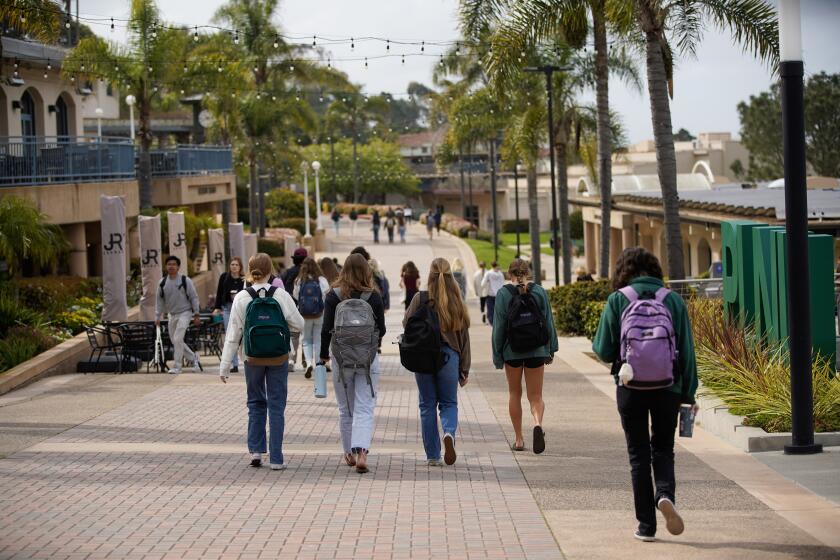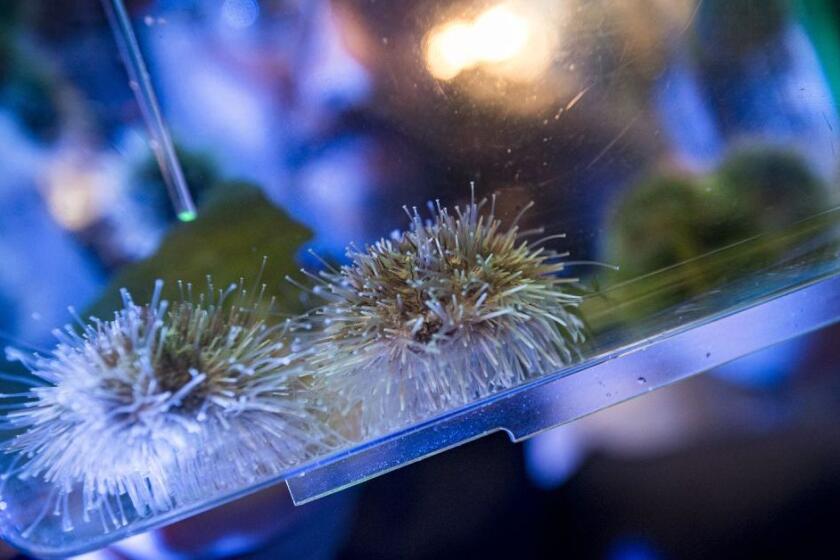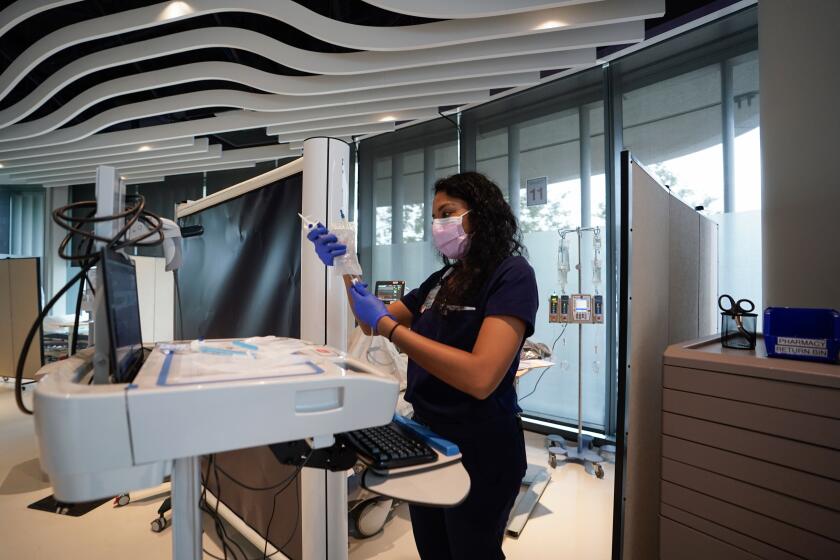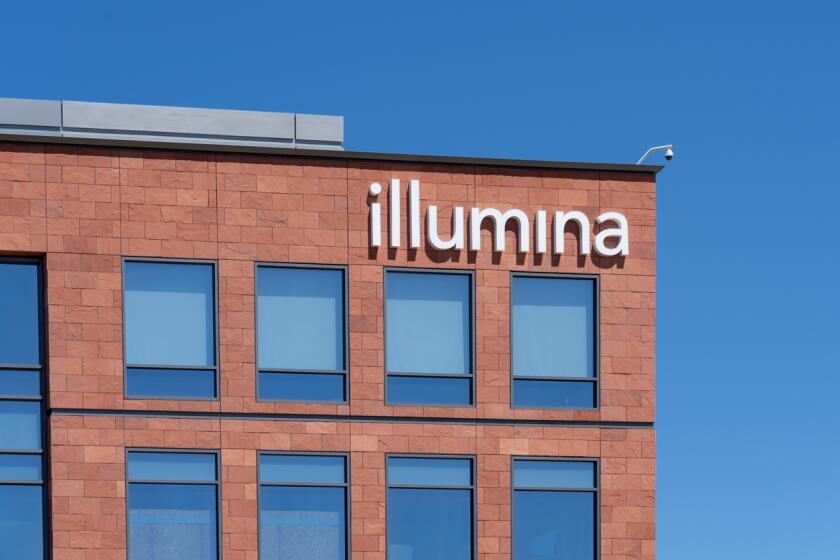Scripps Research president: financial turnaround is near
(Note: This is the first of a two-part question and answer interview with TSRI President Peter Schultz. Go to j.mp/tsrischultz2 to read the second and last part).
The president of the financially troubled Scripps Research Institute in La Jolla on Wednesday said he’ll put the center back in the black within two years through drug-development deals that could eventually be worth billions of dollars.
Peter Schultz also said he has been courting billionaire philanthropists such as Bill Gates and Gerald Chan in hopes that they will invest in his efforts to more quickly turn basic discoveries into medications to treat everything from cancer to tuberculosis.
Toward that end, Scripps Research — which focuses on early stage science in the lab — is absorbing the California Institute for Biomedical Research (Calibr), a nearby center that Schultz founded to develop drugs.
Scripps Research is one of the world’s most respected biomedical institutes. It has discovered drugs such as Humira, which is used to treat rheumatoid arthritis, and ozanimod, an experimental drug for ulcerative colitis. Ozanimod was developed by San Diego’s Receptos, acquired for $7.3 billion in 2015 by Celgene. Such spin-offs bring licensing revenue to Scripps Research — if the drugs are successfully commercialized.
Despite its vaunted reputation, Scripps Research has operated at a deficit for five straight years, largely because of its struggle to obtain National Institutes of Health funding and its limited success in raising private donations. The institute recorded a roughly $20 million deficit during the fiscal year that ended on Sept. 30.
The institute’s board of directors shook things up last year, hiring Schultz, a prominent chemist, as CEO and biologist Steve Kay as president. But Kay returned to the University of Southern California after barely six months in his post, raising fresh concerns about the institute’s direction.
Schultz, now president of the combined Scripps Research and Calibr, discussed the institute’s health and future during a 30-minute interview Wednesday. The conversation has been edited for space and continuity.
Q: Steve Kay left and we never heard any public explanation. What happened?
A: Steve, for personal reasons, decided that he wanted to go back to USC. He’s doing science. We’re great friends. He really enjoyed what he did here. He really helped us get this Calibr-[Scripps Research] merger put together. I think he decided he liked what he was doing at USC more that what he was doing here.
Q: Did you expect that sort of change when you started?
A: It turns out (that) sometimes you get into a job (and) realize that wasn’t quite the best job for you in terms of what you really wanted.
Q: Wasn’t the operating deficit $20 million for the fiscal year that just ended?
A: Well, I think the more important issue here is where we’re going and what we’re doing to build institutes. Because all institutes now, even universities, face the issue of how they’re going to fund themselves well into the future. I think given the ups and downs of NIH funding and the number of people who are applying to the NIH for funding, this is a real problem for everybody to solve.
My focus has not been on an interim solution of “Do I have a $20 million deficit next year?” and “Do I have philanthropy?” It is how do you build a long-term, self-sustaining model for nonprofit biomedical research institutes.
Q: That doesn’t give us a sense of where the institute is now.
A: In two years, I think we’ll start to generate significant surpluses of cash that will allow us to grow — not only the resources we have to do science and drug discovery, but to build an endowment that’s probably going to be, over the next five to 10 years, really significant.
We also have royalty income that we’ve analyzed -- from not one, but four drugs. We’re talking to various groups about monetizing that. There are antibiotics, there are cardiovascular drugs, there’s autoimmune drugs … And I think we could benefit substantially from partnering those drugs. But I think as those drugs mature even more, the benefit to the institute will be greater.
And our financial situation is such that I am not at all interested in partnering those drugs right now, even though they could generate hundreds of millions of dollars in income. … I would far rather hold onto those and partner them in the next one to two years than now. It’s building a long-term model that’s the most important thing to do.
There are a couple of ways research institutes can sustainably support themselves. One of them is through philanthropy. We’ve been working really hard in establishing a network of folks who are very interested in the model we’re building at [Scripps Research]. Bill Gates is very interested in what we’re doing, and he offered to host a dinner for us. Will Hearst of the Hearst Foundation has joined the board.
Q: Early last year, you discussed how Calibr would get drugs developed quickly. What is that plan?
A: The point is, you want to do great research, but you also want to make new medicines. You want to accelerate that process and make it more efficient. It’s really hard to build that model within conventional academic institutions. We built Calibr as a separate organization from Scripps Research. It’s very difficult to go to an academic and say, “To me, Professor X’s research is more important to me than yours.” But in drug discovery, you need to be able to say, “This is probably a more important and technically feasible program than that.”
Q: Is Scripps Research absorbing Calibr?
A: Calibr will move under [the institute], and the institute will be the sole corporate member. The board of Calibr is coming together with the board of the institute. There will be one board of directors.
Q: Devil’s advocate here: You’re talking about a model a lot of people are describing. Are you really so different?
A: Yes. Right now [Calibr has] eight molecules we’re going to put into the clinic in the next two years.
With the Gates Foundation, we have a molecule for [tuberculosis] and one for childhood diarrhea, going into the clinic in the first quarter of next year. We started the Gates collaboration two and a half years ago.
We have a chemical vaccine against malaria, and we have novel antivirals that target not only Ebola but also Marburg and we also have a novel strategy for Zika. That’s just with the Gates Foundation.
We’re just finishing (toxicology studies) with a regenerative medicine for osteoarthritis that [the California Institute for Regenerative Medicine] wants to fund. That’ll be dosed in patients probably in the first quarter of next year.
We have a regenerative medicine therapy for multiple sclerosis that’s a remyelination therapy; it actually repairs the damage from [that disease]. We’re looking at doing a Phase 2b study on that. We have a molecule for metastatic prostate cancer. Wellcome Trust is funding all the manufacturing to make enough product for a Phase 1 trial.
We have probably the solution to the major problem with CAR-T therapy (for cancer), which is due to the acute toxicity. … We’re working with Carl June (a noted physician who pioneered the technology). It could revolutionize CAR-T therapy. We have a molecule for fibrosis that we’ve partnered with pharma.
We have one for chronic heart failure we’ve partnered with pharma. And in that case, the pharma asked us to do the Phase 1 trial. Have you ever heard pharma ask a not-for-profit research institute to run a clinical trial, instead of them?
We have a molecule for childhood diabetes, which is liver-targeted insulin. And we have molecule that could actually change the way we treat autoimmune disease …
We have all of those molecules, and they’re all in late-stage preclinical activities. In the next two years, we think we can put eight molecules into the clinic. In the next four months, there’ll be three — two with the Gates Foundation, one with the California Institute for Regenerative Medicine.
Get Essential San Diego, weekday mornings
Get top headlines from the Union-Tribune in your inbox weekday mornings, including top news, local, sports, business, entertainment and opinion.
You may occasionally receive promotional content from the San Diego Union-Tribune.













